
The Dead Sea Scrolls, also called the Qumran Caves Scrolls, are a set of ancient Jewish manuscripts from the Second Temple period. They were discovered over a period of 10 years, between 1946 and 1956, at the Qumran Caves near Ein Feshkha in the West Bank, on the northern shore of the Dead Sea. Dating from the 3rd century BCE to the 1st century CE, the Dead Sea Scrolls include the oldest surviving manuscripts of entire books later included in the biblical canons, along with extra-biblical and deuterocanonical manuscripts from late Second Temple Judaism. At the same time, they cast new light on the emergence of Christianity and of Rabbinic Judaism. Almost all of the 15,000 scrolls and scroll fragments are held in the Shrine of the Book at the Israel Museum, located in the city of Jerusalem. The Israeli government's custody of the Dead Sea Scrolls is disputed by Jordan and the Palestinian Authority on territorial, legal, and humanitarian grounds—they were mostly discovered following the Jordanian annexation of the West Bank and were acquired by Israel after Jordan lost the 1967 Arab–Israeli War—whilst Israel's claims are primarily based on historical and religious grounds, given their significance in Jewish history and in the heritage of Judaism.

Naracoorte Caves National Park is a national park near Naracoorte in the Limestone Coast tourism region in the south-east of South Australia (Australia). It was officially recognised in 1994 for its extensive fossil record when the site was inscribed on the World Heritage List, along with Riversleigh. The park preserves 6 km2 of remnant vegetation, with 26 caves contained within the 3.05 km2 World Heritage Area. Out of the 28 known caves in the park, only four are open to the public. Other caves are kept away from the public eye as they are important for scientific research and also for the protection of the caves and their contents. Many of the caves contain spectacular stalactites and stalagmites.

Chillagoe-Mungana Caves is a national park in Chillagoe, Shire of Mareeba, Queensland, Australia.
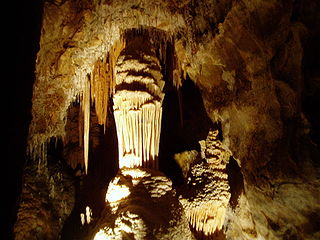
The Jenolan Caves are limestone caves located within the Jenolan Karst Conservation Reserve in the Central Tablelands region, west of the Blue Mountains, in Jenolan, Oberon Council, New South Wales, in eastern Australia. The caves and 3,083-hectare (7,620-acre) reserve are situated approximately 175 kilometres (109 mi) west of Sydney, 20 kilometres (12 mi) east of Oberon and 30 kilometres (19 mi) west of Katoomba. Dating back to 340million years ago, it is the oldest known and dated open cave system in the world.
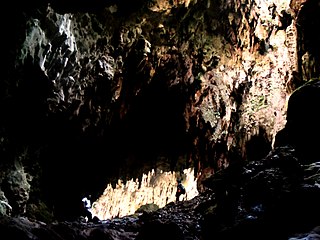
Callao Cave is one of 300 limestone caves located in the Barangays of Magdalo and Quibal in the municipality of Peñablanca, about 24 km (15 mi) northeast of Tuguegarao City, the capital of Cagayan province within the Peñablanca Protected Landscape and Seascape in the western foothills of the Northern Sierra Madre Mountains on Luzon island in the Philippines. The town Peñablanca's name refers to the predominance of white limestone rock formations in the area. First excavated in 1980 by Maharlika Cuevas, the seven-chamber show cave is the best known natural tourist attraction of the Cagayan province and in February 2020 has officially been recognized as an important cultural property of the Philippines.

Pictograph Cave is an area of three caves located 5 miles (8.0 km) south of Billings, Montana, United States, preserved and protected in the 23-acre (9.3 ha) Pictograph Cave State Park.
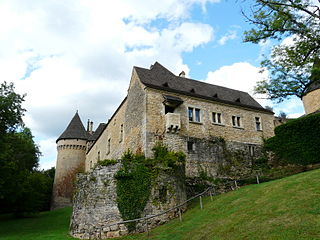
Montignac-Lascaux, is a commune in the Dordogne department, Nouvelle-Aquitaine, Southwestern France. It is a small town situated on the Vézère river and has been the capital of the canton of Montignac since 1790. In 2015 it became the capital of the newly created Canton de la Vallée de l'Homme. The poet Pierre Lachambeaudie (1806–1872) was born in the village.

The Edakkal caves are two natural caves at a remote location at Edakkal, 25 km (15.5 mi) from Kalpetta in the Wayanad district of Kerala in India. They lie 1,200 m (3,900 ft) above sea level on Ambukutty Mala, near an ancient trade route connecting the high mountains of Mysore to the ports of the Malabar Coast. Inside the caves are pictorial writings believed to date to at least 6,000 BCE, from the Neolithic man, indicating the presence of a prehistoric settlement in this region. The Stone Age carvings of Edakkal are rare and are the only known examples from South India besides those of Shenthurini, Kollam, also in Kerala. The cave paintings of Shenthurini (Shendurney) forests in Kerala are of the Mesolithic era.
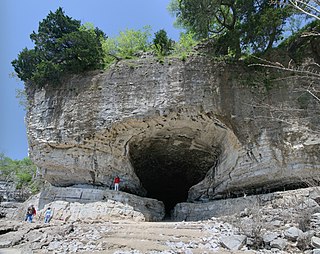
Cave-In-Rock State Park is an Illinois state park, on 204 acres (0.83 km2), in the town of Cave-in-Rock, Hardin County, Illinois, in the United States. The state park contains the historic Cave-In-Rock, a landmark of the Ohio River. It is maintained by the Illinois Department of Natural Resources (IDNR).

Fort Rock Cave was the site of the earliest evidence of human habitation in the US state of Oregon before the excavation of the Paisley Caves. Fort Rock Cave featured numerous well-preserved sagebrush sandals, ranging from 9,000 to 13,000 years old. The cave is located approximately 1.5 miles (2.4 km) west of Fort Rock near Fort Rock State Natural Area in Lake County. Fort Rock Cave was declared a National Historic Landmark in 1961, and added to the National Register of Historic Places in 1966.
Clover Hollow Natural Area Preserve is a Natural Area Preserve located in Giles County, Virginia. The 25-acre (10 ha) preserve protects Stay High Cave, which houses seven rare cave-dwelling invertebrate species, three of which are only known from the county's Sinking Creek Valley. More common species, such as salamanders, crickets, harvestmen, spiders, crayfish, and bats, also live within the cave's streams, riparian mud banks, and drip pools. Most water in the cave stream comes from forested slopes.
Ogdens Cave Natural Area Preserve is a 131-acre (53 ha) Natural Area Preserve located in Frederick County, Virginia. The preserve protects a cave that carries a below-ground branch of Buffalo Marsh Run, which also flows overland through the preserve.
Unthanks Cave Natural Area Preserve is a 171-acre (69 ha) Natural Area Preserve in Lee County, Virginia. It protects the entrance to Unthanks Cave, which houses significant biological diversity and a wide variety of invertebrate life. The cave's streams drain a significant karst area south of the Powell River.
Koonalda Cave is a cave in the Australian state of South Australia, on the Nullarbor Plain. It is located within the Nullarbor Wilderness Protection Area, 99 kilometres (62 mi) west of the Nullarbor roadhouse and 97 kilometres (60 mi) north east from Eucla, Western Australia It is notable as an archeological site.

Graham Cave is a Native American archeological site near Mineola, Missouri in Montgomery County in the hills above the Loutre River. It is located in the 356 acre Graham Cave State Park. The entrance of the sandstone cave forms a broad arch 120 feet (37 m) wide and 16 feet (5 m) high. Extending about 100 feet (30 m) into the hillside, the cave protects an historically important Pre-Columbian archaeological site from the ancient Dalton and Archaic period dating back to as early as 10,000 years ago.

Piccaninnie Ponds Conservation Park, formerly the Piccaninnie Ponds National Park, is a protected area of 862 hectares located in southeastern South Australia near Mount Gambier.
The Bull Thistle Cave Archaeological Site is an archaeological site on the National Register of Historic Places, located in Tazewell County, Virginia. It is a vertical shaft pit burial cave. The distribution of the skeletal remains indicates that bodies were either thrown or lowered into the cave. On the surface of the cave floor, researchers have discovered the remains of a minimum of 11 bodies. Based on an artifact recovered from the site, it is estimated that the cave was used for burials between 1300 and 1600 AD.

Graham Cave State Park is a state park in the U.S. state of Missouri consisting of 369 acres (149 ha) located in Montgomery County. The park's namesake, Graham Cave, is a cave in St. Peter sandstone with an entrance 120 feet (37 m) wide and 60 feet (18 m) high and an extent of about 100 feet (30 m) into the hillside. The cave protects an historically important Pre-Columbian archaeological site dating back to as early as 10,000 years ago. Visitors are allowed up to the entrance of the cave where interpretive signs point out significant discoveries. The park includes the 82-acre (33 ha) Graham Cave Glades Natural Area which protects an area of sandstone and dolomite glades with a rich diversity of glade species. The park is adjacent to Interstate 70 from which the entrance to the cave can be glimpsed during foliage-free months.
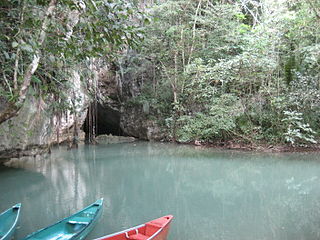
Barton Creek Cave is a natural cave in Belize, known as both an archaeological site and as a tourist destination. It is located in the upper Barton Creek area near San Ignacio in the Cayo District.

The Tantanoola Caves Conservation Park is a 14-hectare (35-acre) protected area near Tantanoola in the Limestone Coast tourism region in the south-east of South Australia. The conservation park preserves two main caves; the wheelchair accessible Tantanoola Cave which is developed as a show cave and Lake Cave which is a restricted access cave used by the Department for Environment and Water scientists as a reference site for other karst features in the region. Visitors can explore the information centre and learn about the caves during a guided tour.























